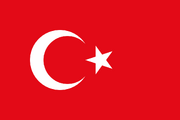The flag Lebanon consists of three horizontal bands consisting of red (top), white (middle, double width), and red (bottom) with a green cedar tree centered in the white band.[3]

Variant of the flag with brown trunk and branches
Symbolism[]
Historically, the red and white colours had been associated, respectively, with the Kayssites and the Yemenites, clans that had reputedly existed in the Arabian peninsula/Lebanon area for more than a thousand years.
- Red colour signifies bloodshed in freedom struggle.
- White represents peace.
- The cedar tree is the symbol of steadiness and immortality.[1]
History[]

The flag of the Ottoman Empire was used until October 1, 1918
On September 1, 1920, the state of Greater Lebanon, with French military administration, was proclaimed under a flag derived from French and biblical symbols. The cedar tree was pictured on the white central stripe of the French Tricolour, although earlier it had been emblazoned on a plain flag carried by Christian troops in the Lebanese Legion during World War I. In early historic times cedars of Lebanon were plentiful throughout the area. The cedar tree was mentioned in the Bible as a symbol of strength and wealth and had long been associated with the Lebanese Christian minority.
During World War II the Free French forces who overthrew the Vichy regime in Lebanon wanted to assure themselves of support from the local population and consequently ended the League of Nations mandate, proclaiming Lebanon's independence in November 1941. No change was made in the national flag at that time. The so-called National Pact, agreed upon and proclaimed in 1943, divided power among the Christians, Sunnite Muslims, and Shīʿite Muslims. A new national flag was then created that maintained the cedar tree but eliminated the French Tricolor. The stripes of the new flag were horizontal instead of vertical and limited to red and white. The cedar of the 1943 flag was supposed to be entirely green, although later representations sometimes added a naturalistic brown to the trunk and branches.[4]
References[]
Asia
|
|---|
| Nations Transcontinental Nations Nations with limited/no recognition Territories |



